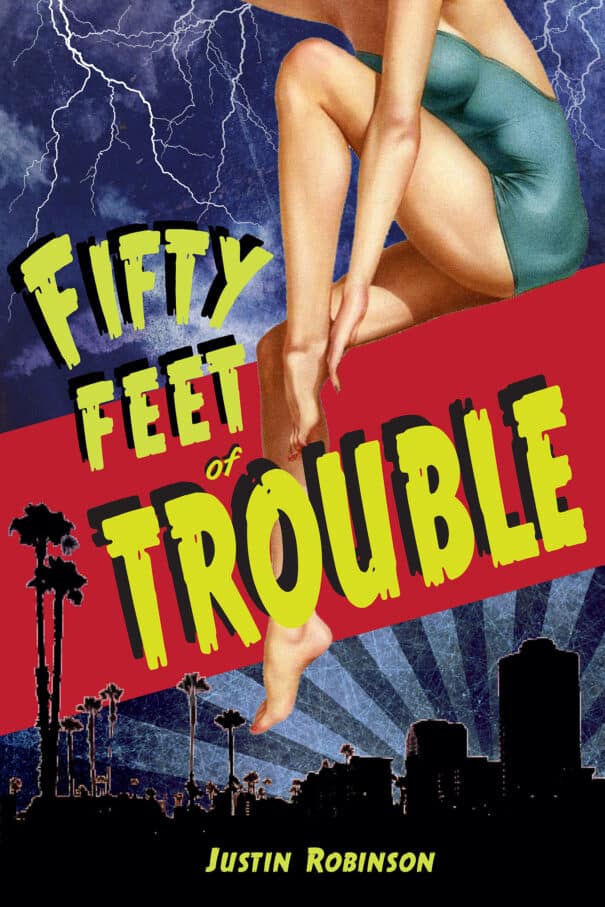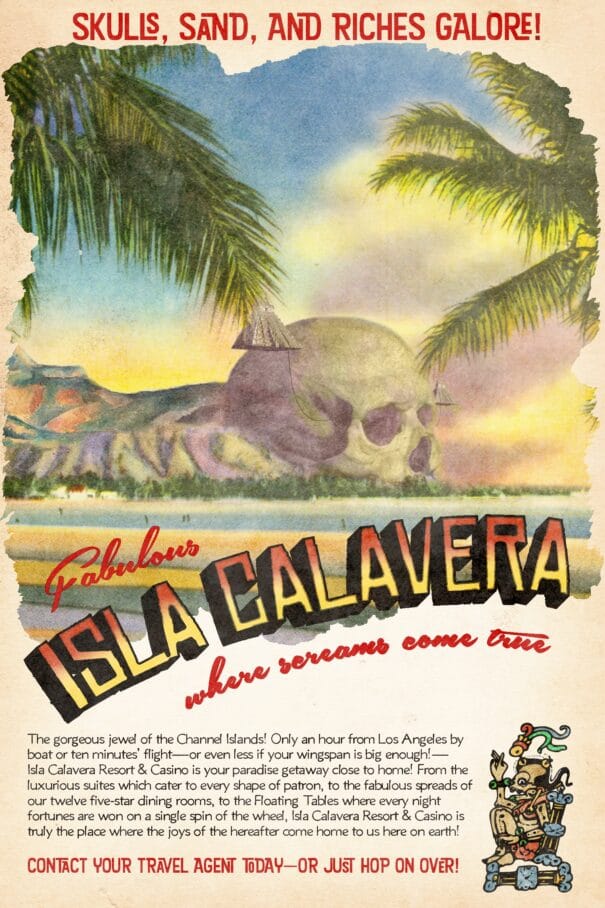 Justin Robinson shares his thoughts about creating Fifty Feet of Trouble:
Justin Robinson shares his thoughts about creating Fifty Feet of Trouble:
That I would return to the City of Devils universe was a given. Honestly, if I had my druthers I’d never leave it. I’d just keep expanding it and expanding it, moving past the Walter Mosley-meets-Roger Corman detective stories of Nick Moss and into the larger world now ruled by monsters. There’s so much more out there than Nick will ever encounter in his tiny corner of Los Angeles, and for a history nerd like me, it’s so much fun holding up a funhouse mirror to the recent past.
I have an enduring fascination with the femme fatale trope, but I’m much more interested in deconstructing it (that’s one of the mission statements behind the Fill in the _____ series, which you can see in the characters of Mina Duplessis and Heather Marie Tooms, among others). And at the same time, giant monsters were notably absent from the first book, but they’re a vital part of creature features as a whole. So when I hit on the idea of Nick being hired by the fifty foot woman, I wanted to underscore the idea that, while she’s gorgeous, she’s also fifty feet tall, and thus kind of terrifying for our perpetually nervous hero. She’s a femme fatale partially because there’s a decent chance she might step on you.
In the original outline, he meets Pilar O’Heaven first, rather than nineteen chapters in. She’s the character who sets him on the case of the book. That’s when I went back to the first book and noticed I’d written myself into a corner with Hexene. Fortunately, I knew even then that I wanted to try out another noir trope — the multiple cases that all turn out to be the same one — and was able to work that into the larger whole. Now Pilar enters the book almost halfway through, and I like the way she immediately bends the narrative with her weight. Her physical size is in direct proportion to her importance to the larger narrative. Plus, I like Pilar, mostly because (between you and me), she’s guilty of what HUMAC was accusing her of.
Incidentally, Catalina Island is 22 miles long and about 22 miles off the coast of California. Nick arrives in Chapter 22. If you figure that’s intentional, you know me too well.
Without giving too much away, I wanted to discuss some of the monsters that appear in this book. Because the world is so big, I decided to focus on entirely different beasts, specifically relegating monster types that had large roles in the first book into the background. My plan is to keep doing this as much as possible in subsequent books. I really can’t wait to get out into the giant ant-infested Arizona deserts.
When I was writing the Reverend Bobo Gigglesworth, I was initially concerned that he might come off as anachronistic. After all, our culture-wide entirely-rational terror of clowns is a relatively new phenomenon. My idea was that clowns in the City of Devils-verse are something like those creepy 1930s cartoons. They are extremely powerful, up there with witches in terms of what they can do, but ultimately their purpose is to amuse themselves. They want to interact with the world as though it’s a cartoon, but that can be somewhat painful for the flesh-and-blood denizens. By grounding the clown in the nightmare world of Fleischer cartoons, I was able to make them feel at home in the 1950s world. At least for me.
It might sound a little strange that mad scientists are a kind of monster. I went with this because of the sheer number of monsters in creature features that were created by them. The mad scientist is the counterpart of the witch. Witches deal in magic; mad scientists deal in a kind of ersatz super-science. It shouldn’t work, but it does. Try to figure out why, and all you’re going to get is a rant about atomic supermen. This also lets me populate the world with the kind of giant monsters and hybrids you see in atomic horror films, which are solidly in the fiction of the time, but don’t seem like they could or should have a human origin.
The jaguar people are from the 1942 flick Cat People, which I highly recommend if you’ve never seen it. The 1982 remake is deliriously sleazy, but lacks the classic menace of the original. Because of the nature of the book, I wanted to play up the silly parts of a perpetually-horny race that turns into monsters at the first hint of reciprocation. And because jaguars are a South American species, I figured that’s where they were from. The floating step pyramids play into that, and I liked the way those looked against the skyline in my mind’s eye.
It’s tough to explain the blobs. In the first book, only a single blob appears in the background, as a guest to one of Oculon’s parties. In this book, they’re depicted as solidly blue-collar monsters (or would be, if they didn’t keep eating their collars), so I’m not sure who that guy at Oculon’s party was. Maybe he was the head of the trash collectors’ union. I liked the idea that blobs are sort of eldritch monstrosities, who don’t really experience time and space the way people, but are still really cheerful and friendly if you talk to them. Gelatin Keyes is one of my favorite characters I’ve ever gotten to write, but I wanted to use him sparingly. A little Keyes goes a long way. I worried that he’d overshadow the more important characters if he hung around too much.
As for our hero, Nick, I wanted a case that would draw on his past. I have his biography sketched out in some detail. We’ve gotten to know his world, so it was time to get to know him a little more. Linking the cases here to his first case as well as his only real monster phobia was a way to add a little more heft to what could be a trifling story.
 More than anything, though, I wanted to look at what the world had become. We have the long term fallout of people being kidnapped at will by monsters. Any links you might draw to modern conversations on entitlement, gender, and race are there on purpose. It’s my way to kind of muddle through them as best I can, by projecting myself into a situation where I would be in the kind of danger that faces those less privileged than me every day. The most chilling parts to me, and I try to put them in every book, are when the monsters are completely unconcerned by a potential abduction. It’s a comedy, but it’s also a world where human life is bought cheap.
More than anything, though, I wanted to look at what the world had become. We have the long term fallout of people being kidnapped at will by monsters. Any links you might draw to modern conversations on entitlement, gender, and race are there on purpose. It’s my way to kind of muddle through them as best I can, by projecting myself into a situation where I would be in the kind of danger that faces those less privileged than me every day. The most chilling parts to me, and I try to put them in every book, are when the monsters are completely unconcerned by a potential abduction. It’s a comedy, but it’s also a world where human life is bought cheap.
Moments of honest connection matter too. While Nick and Hexene are the most obvious for these, I thought the quick scene between Nick and Ensign Pulverized was just as important. These two are separated by species-lines, by the barrier between the living and the dead, but they were both vets of the Day War. They get things about each other that others never will.
I think I’ve rambled enough here. I am immensely proud of Fifty Feet of Trouble. I believe it’s the best thing I’ve written and I hope readers can engage with it on a variety of levels. First and foremost, I hope I’ve written a ripping good yarn. A noirish tale with a cockeyed sense of humor that’s built to last. And don’t worry. Nick Moss will return. In some form or another.
Artwork: top, Kate Sullivan; bottom, Alan C. Caum
